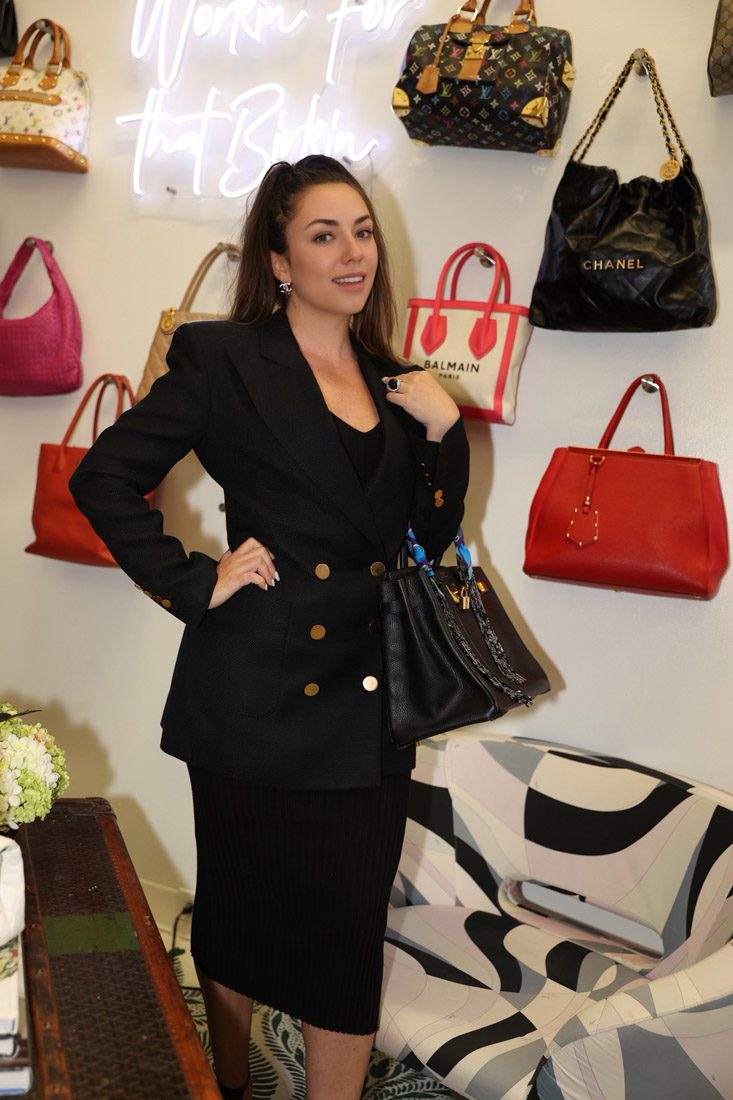HOW TO BE A SUSTAINABLE FASHIONISTA!
Laura Nay once lived in a long and narrow piedá- terre over a bookshop in Paris. “I would sit there and stare at the fashionable people walking in and out,” she says of the charming view. “And they were just so interesting— silk scarves tied around their necks or their heads, dripping in pearls and wearing ragged real denim.” The bookshop is the namesake for her Miami Circle boutique La Librairie, where she is on a mission to empower women through her curated vintage and consignment pieces.
“Shopping vintage has always been a part of my soul,” Nay says. While selling antiques at a design shop, a client came in and asked about her outfit, saying, “I wish you would dress me every day,” and the light bulb went off. Five days later, she opened her store with the encouragement of Interiors Market owner Milton Roberts who told her, “You have to share how to wear vintage with the world.”
“I truly believe that it makes your wardrobe more interesting and more stylish when you are crossing eras—something you simply can’t get from fast-fashion,” she says. Nay advocates for a more thoughtful approach to fashion consumption, mixing vintage finds with new pieces. There is value in timelessness, quality and classic fits. Here, she shares her approach for incorporating more sustainable choices into a wardrobe without compromising style.
Ingredients matter
Shopping for high quality items doesn’t have to mean breaking the bank. Instead, look for natural fibers such as wool, cotton, linen, silk and cashmere. “These materials will last, feel better to the touch and are naturally biodegradable,” Nay says. The poor quality of most fast fashion contributes to massive waste, so consider the entire lifecycle of a garment or accessory from the sourcing of materials, the manufacturing process, its longevity and disposal.
Embrace creativity
Mixing in vintage and thrifted, whether from consignment stores, estate sales or online marketplaces, lends itself to a curated and more interesting way to dress. “I think vintage fashion is so interesting and so well made,” Nay says. “They don’t make it like they used to.” Take a Chanel jacket, for instance. “It has eight seams, and they allow you to size up two sizes or down two, which is typically the most people fluctuate. That gives you a four-size parameter,” she says. You could have such a jacket for the rest of your life.
Befriend a tailor
Finding and working with a tailor can be a recipe to transform ill fitting wardrobe pieces into favorites. Nay recounts a story of a woman who wanted to consign a pair of moth-eaten Chanel trousers. “Everyone was like, ‘Laura, why are you taking these ruined pants?’” Nay knew she just needed to find the right customer to wear chic, cuffed shorts. “Sure enough, a woman comes in…the perfect size, and I cut them right in the store,” she says. The garment was saved from the landfill, and a customer found a new favorite. Besides fashioning the most flattering fit, a savvy tailor can find ways to reimagine pieces that may look past their prime. “Sustainable fashion is also about using your imagination, befriending a very good tailor and making those things fit both you and your personality,” Nay says.
Look for timeless elegance
“Look for timelessness and classics,” Nay says. Choose quality over quantity by investing in well-made items designed to last. Look for items such as blazers and trousers. “A white cotton shirt with black pants can never go out of style. Add a thrifted ’80s belt and a blazer, and you [will look like a] super stylish, interesting person.” Finding classics reduces demand for fast fashion and ensures your wardrobe is filled with evergreen pieces that can be worn for years to come.
Add a pièce de résistance
Nay excels at helping clients mix and match old and new to fit each personality. One of her best tips: Rework things you already own and mix in vintage jewelry. “It’s the last part of the sustainability equation,” Nay says. “It curates a unique look, and you feel more confident because no one else is wearing the same outfit as you.”
LA LIBRAIRIE
shoplalibrairie.com
@shoplalibrairie






